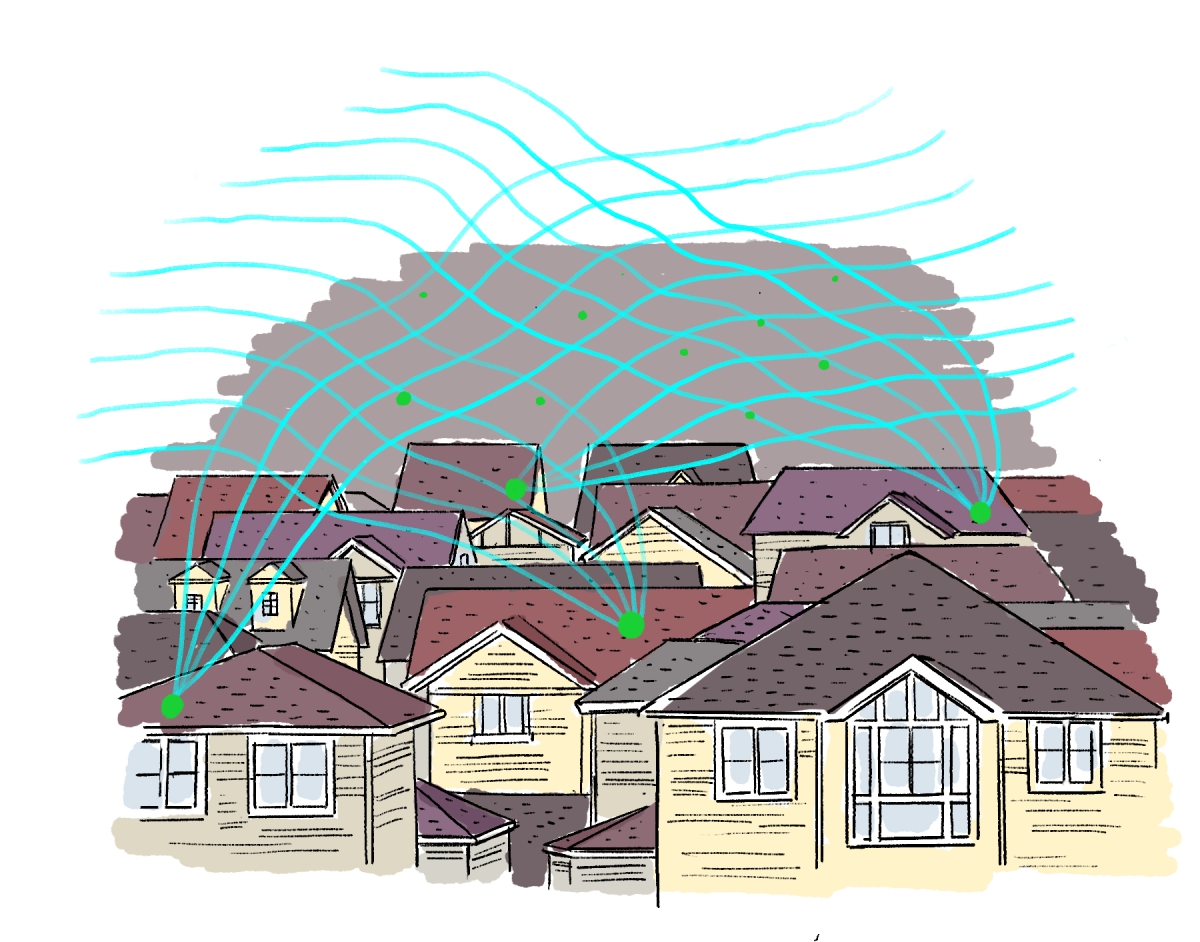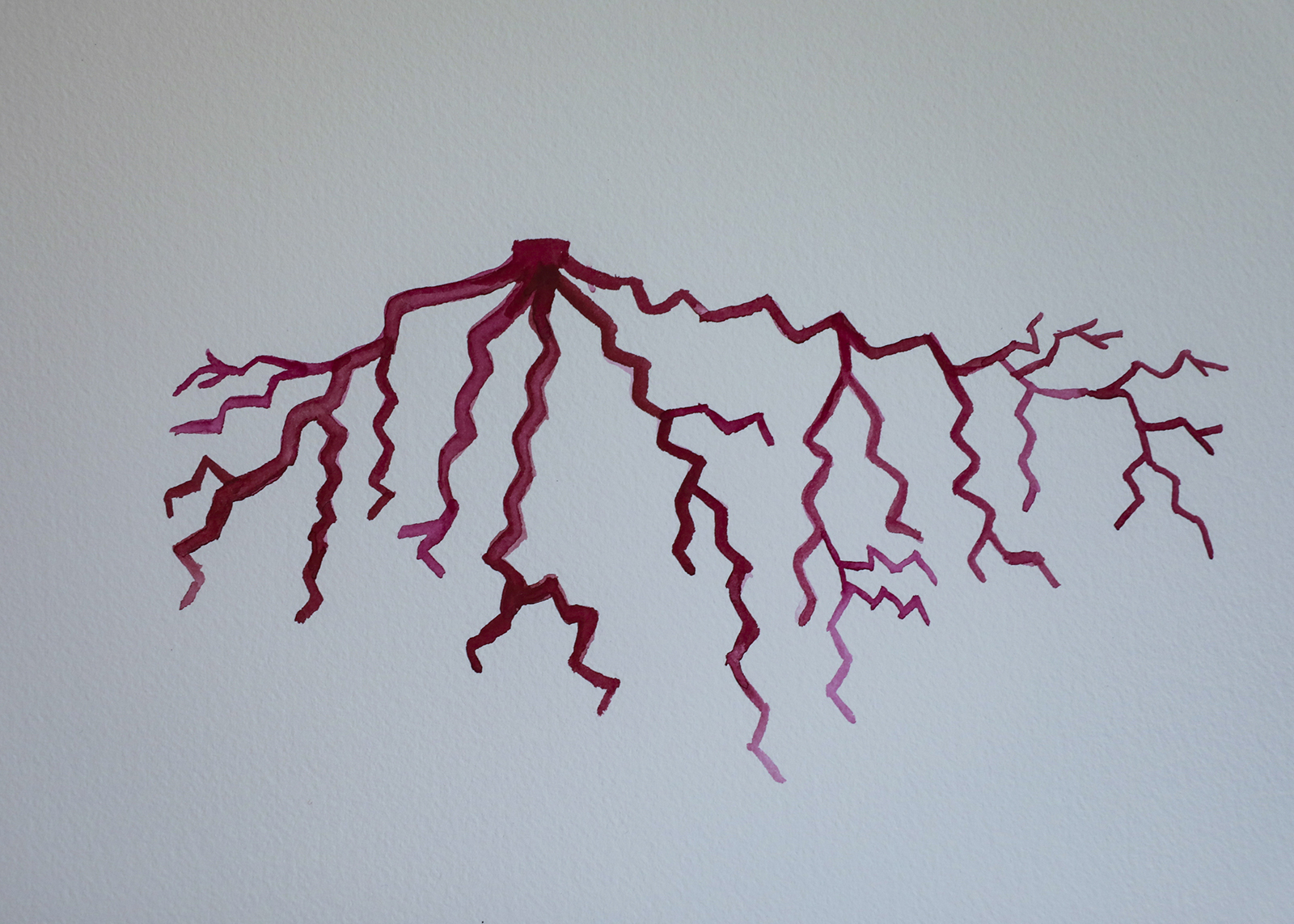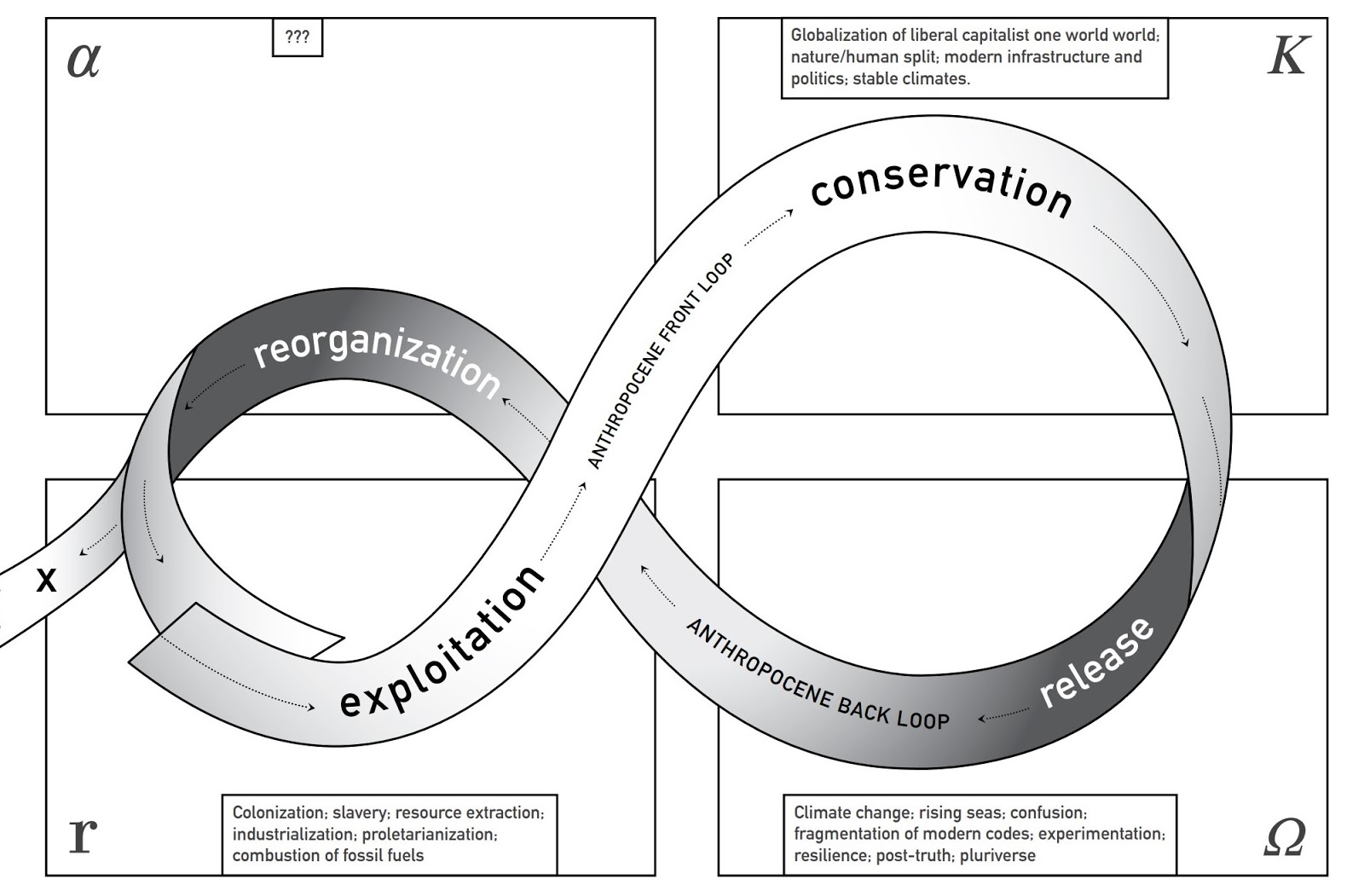ARPANET – Advanced Research Projects Agency Network – a project instigated in 1966 by the United States Department of Defense that allowed remote computers to communicate across a network. Essentially, the predecessor of the internet.
Artwashing – The use of art and artists to facilitate or distract from negative shifts in a neighbourhood – often in terms of gentrification. See Boyle Heights.
Civil Society – sometimes called the “third sector” includes those working beyond government and/or commerce: community groups, non-profits, labour unions, NGOs [non-governmental organizations], charitable organizations, faith-based organizations, professional associations, and foundations. Although operating outside of governments, when mobilized, civil society has the power to hold significant influence. With notes from the World Economic Forum.
Commons – From Alexandre Monin’s “On negative commons”: “The notion of “commons” rediscovered through the work of researchers in recent years, particularly that of Elinor Ostrom, the 2009 Nobel Memorial Prize winner in Economic Sciences, designates realities that are held in common, neither privately nor publicly owned. Often commons are characterized through the association of a resource, a community and democratically chosen rules of governance of the aforementioned resource.”
Disaster Capitalism – the ways in which capitalism makes profit from disaster and catastrophe. Naomi Klein details the strategy in her framing of the ‘shock doctrine’: “Exposing the ways in which the exploitation of disaster and crisis have been utilized as tools of economic strategy, she reveals a number of incidences where the strategy has been applied: “That is how the shock doctrine works: the original disaster—the coup, the terrorist attack, the market meltdown, the war, the tsunami, the hurricane—puts the entire population into a state of collective shock.” Battle, Disaster as a Framework for Social Change, with notes from: Naomi Klein, The Shock Doctrine: The Rise of Disaster Capitalism (Vintage Canada, 2007),19.
Fault Tolerance – The ability of a system to continue to function properly despite the failure of one (or some) of its component parts.
Hub and Spoke Network – Every location in the network is connected through a central location, a hub. As a network grows, and resources increase, direct (point-to-point) connections become more feasible.
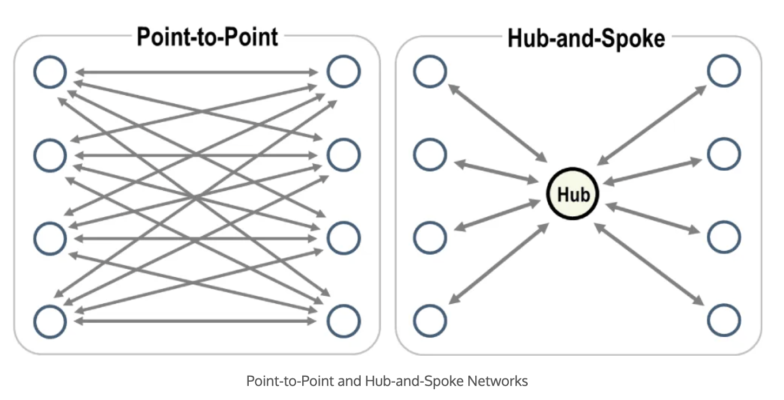
ISPs – ISP stands for Internet Service Provider, and is an organization or group that provides services of access to the internet for users. While an ISP could be community or privately owned (commercial or non-profit), currently, they are overwhelmingly dominated by corporate companies aiming to make a profit.
Mechanism Design – Sometimes called reverse game theory, since it begins at the end and works backwards. A field in both economics and game theory, Mechanism Design takes an ‘objectives-first’ approach to designing economic systems.
Mukbang – (also known as meokbang). An ‘eating show,’ popularized in South Korea in 2010, where a host consumes various quantities of food while interacting with the audience.
Negative Commons – Stephanie Wakefield refers to this in her talk: “what do we do with these negative commons that we all inherit?” and references The work of Alexandre Monnin and Lionel Maurel who note: “The negative commons designate “resources”, tangible or intangible, “negative” such as waste, nuclear power stations, polluted soils or even certain cultural heritages (the right of a colonizer, etc.).”
also see: https://politiquesdescommuns.cc/glossaire?#communnegatif
Network – In online terms, a network is a group of computers that talk to one another. “The simplest network is a centralized one, a hierarchical structure where each branch of the hierarchy is subordinate to the centre and where all activity travels from centre to periphery. [Galloway, Protocol: How Control Exists After Decentralization, 30] Decentralized networks, on the other hand, define the structure that much of our modern online systems have been based on, and operate primarily at the local level in turn effecting the global. The Domain Name System (DNS), the way in which sites on the internet are named and connected to one another, essentially the fundamental organizational system of the internet, is a hierarchical system based on the decentralized model. [Battle, Disaster as a Framework for Social Change, 75] Our contemporary network model has started to shift from the decentralized system to one that is overwhelmingly distributed as can be seen by the rise in cloud computing. The distributed network has no central hub, “instead each entity in the distributed network is an autonomous Agent.”(Galloway, Protocol, 33.) [Battle, Disaster as a Framework for Social Change, 76].
also see: https://www.shareable.net/how-to-set-up-an-open-mesh-network-in-your-neighborhood/
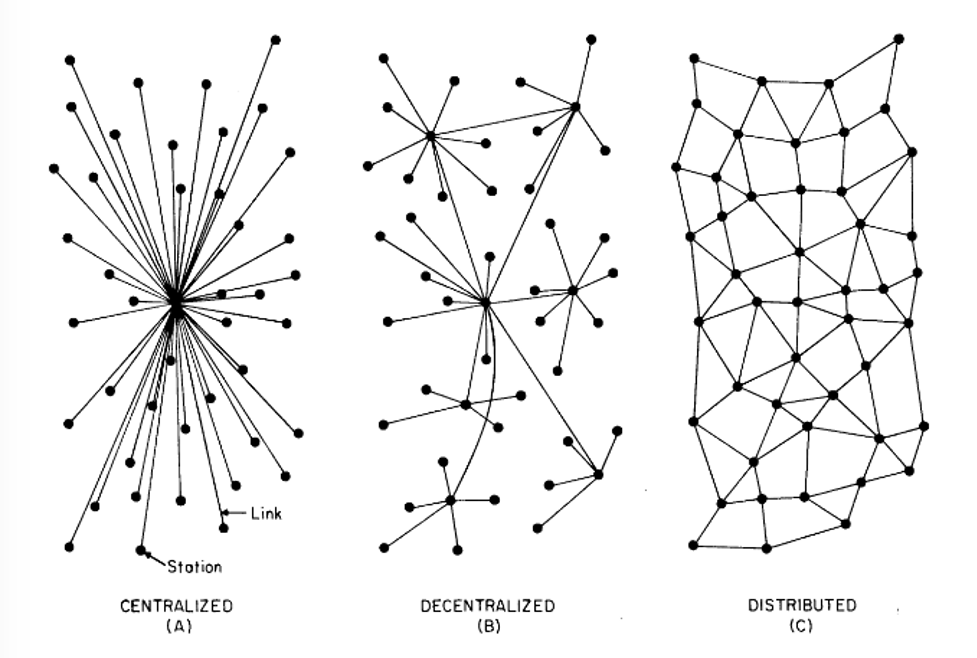
Centralized, Decentralized and Distributed networks, from On Distributed Communications, prepared for the United States Air Force Project Rand (The Rand Corporation) by Paul Baran, 1964.
Nodes – “Each point in a distributed network is neither a central hub nor a satellite node – there are neither trunks nor leaves. The network contains nothing but “intelligent end-point systems that are self-deterministic, allowing each end-point system to communicate with any host it chooses.” Like the rhizome, each node in a distributed network may establish direct communication with another node. [Galloway, Protocol, 11]
Resilience – Is defined (merriam webster) as:
1: the capability of a strained body to recover its size and shape after deformation caused especially by compressive stress.
2: an ability to recover from or adjust easily to misfortune or change
It is often discussed (in a cultural, sociological, or political sense) in terms of an ability to overcome oppression.
I appreciate Wakefield’s call to move beyond resilience as a goal: “I seek instead to make ‘use’ of resilience, to contribute to a broad shift from critique to construction or experimentation (Last, 2012 ). [Inhabiting the Anthropocene back loop Stephanie Wakefield]
also see: Anthropocene Hubris, by Stephanie Wakefield.
also see: Stephanie Wakefield’s conversation: “So, um, you know, in the, in the redefinition of life as infrastructure, I think there are both positives and negatives, you know, on the one hand, it is a very dismal view of what human beings can be that, you know, maybe that, that we’re rethinking human being as just merely surviving or merely adapting to crisis, you know, because the whole thing with resilience infrastructure is that it is a necessary piece of a broader system, right? Resilience infrastructures are not going to replace modern infrastructures, they don’t replace all the power plants, they don’t replace, you know, all the greenhouse gas emissions, they don’t replace the global systems, the logistics, and so on, they just mitigate the effects of them. Right. So they mitigate the disasters produced by those systems. So they’re, you know, they’re, they’re like a life support system, they get added to an ongoing, you know, technosphere that’s there. Right.
So, so to me, like, the question is, obviously, then well, you know, is there anything more than that, is anything better than that, that can be thought that could be imagined that could be built, you know, as a way forward as a way of prying open some kind of exit out of the situation that we find ourselves in, you know, both for ourselves living right now and for the people who are going to come after us,”
Quadratic Voting –essentially a collective decision making procedure that helps address issues that arise within scenarios involving social choices. Quadratic voting emphasizes degree of preference and is often instituted in models where an individual can pay (using real or artificial currencies) for additional votes.
also see: Quadratic Payments: A Primer
Resources
Looking closer to the ways that plants and seeds spread. By way of example: Mychorrizal fungi and symbiotic systems of exchange within plants (see: Grasping at the Roots); Phosphorous/carbon exchange systems in fungi; and C4 pathways of photosynthesis (as researched for connecting thru grasses)
Neighborhood Network Construction Kit Guidelines for Mesh Networks – Community Technology Field Guide
The Feminist Economics Department
True Currency: About Feminist Economics – Project & Podcast
Suggested Readings
Disaster as a Framework for Social Change: Searching for new patterns across plant ecology and online networks – Christina Battle
What Is Blockchain And What Can Businesses Benefit From It? – Arthur Iinuma, Forbes
COVID-19 and ‘Reinventing’ a New Economic Model – Ahmed Fayed, The Cairo Review of Global Affairs
How the EU could pioneer a new economic model for the post-Covid-19 world – John Milbank and Adrian Pabst, The New Statesman
Before Everyone Was Talking About Decentralization, Decentralization Was Talking to Everyone – Amelia Winger-Bearskin, Immerse
Elements of Technology Criticism – Mike Pepi
Antecedent Technology Don’t colonize our future – Amelia Winger-Bearskin, Immerse
Jaron Lanier fixes the internet – New York Times
Should We Treat Data as Labor? Moving Beyond “Free” – Imanol Arrieta Ibarra, Leonard Goff, Diego Jimenez Hernandez, Jaron Lanier, and E. Glen Weyl
The New Astrology – Alan Jay Levinovitz
Quadratic Voting: How Mechanism Design Can Radicalize Democracy – By Steven P. Lalley and E. Glen Weyl
Mechanism Design: The Essence Of Modern Problem Solving – By Michael Albert
Winning back the Internet by building our own – Tech Learning Collective
The Lure of Possible Futures: On Speculative Research by Martin Savransky, Alex Wilkie & Marsha Rosengarten
Reenvisioning the Internet: Create Tools that Reveal its Ideological Infrastructures – Gary Zhexi Zhang
Reenvisioning the Internet: Embrace Its Multiplicity – Mimi Onuoha
Cash Back: Yellowhead Institute Red Paper
Making nature into infrastructure: The construction of oysters as a risk management solution in New York City – Stephanie Wakefield
Medium Design: Knowing How to Work on the World – Keller Easterling
Publication: Imagining new systems of exchange
